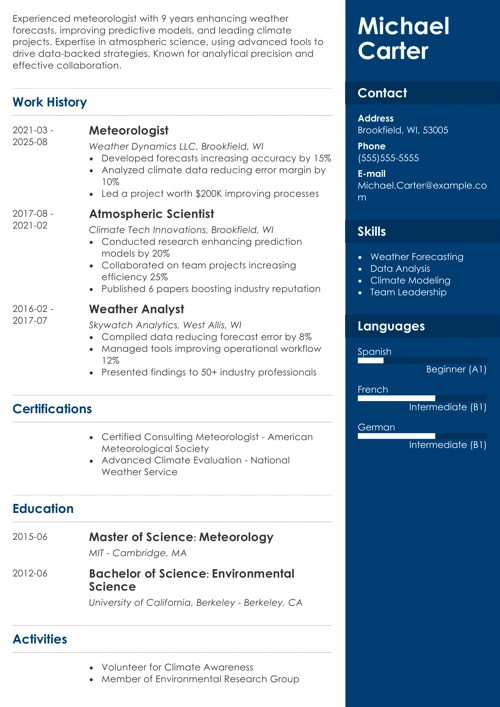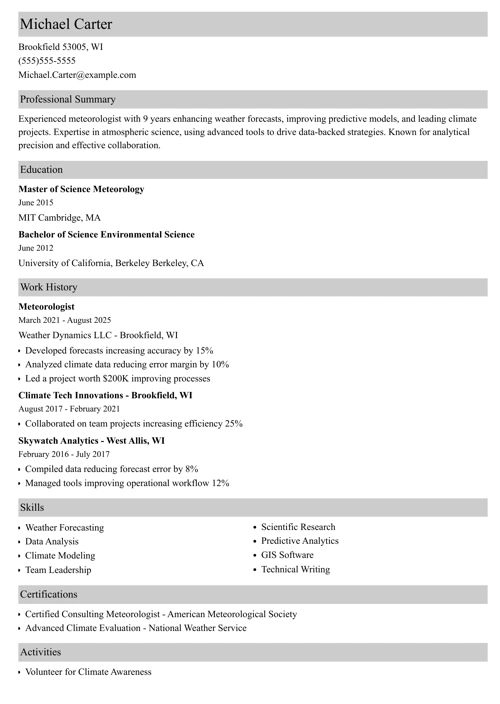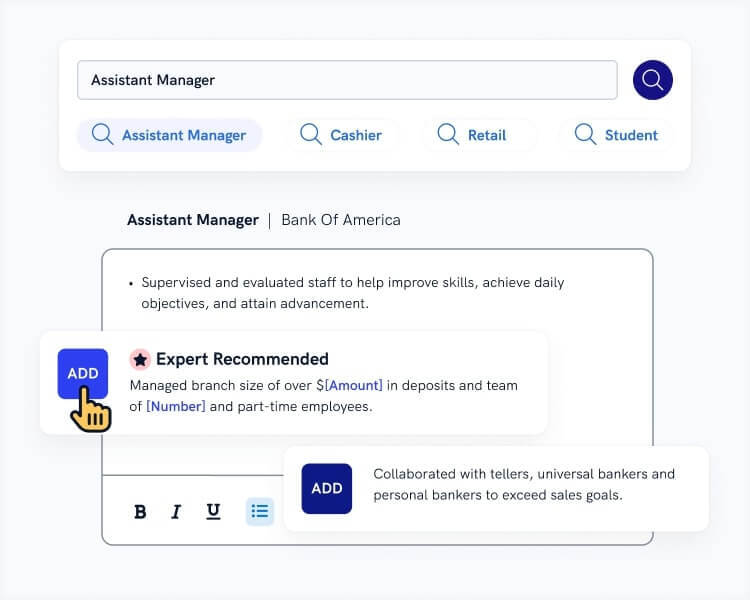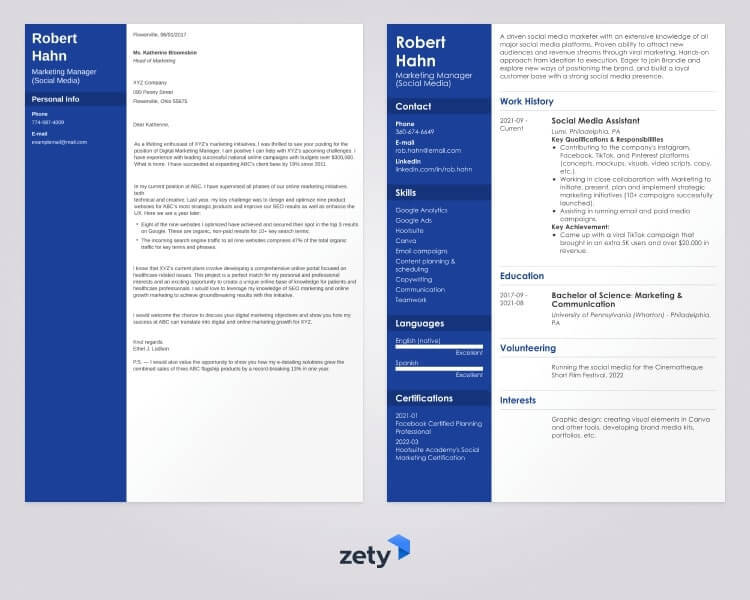A career in meteorology is not just about your enthusiasm for weather phenomena—your meteorologist resume must powerfully present your skills and passion. This guide offers expert advice and meteorologist resume examples to help you create a compelling resume that showcases your qualifications and experiences, making you stand out to potential employers.
This guide will show you:
- A meteorologist resume example that distinguishes itself from the rest.
- Tips for crafting a meteorologist resume that enhances your interview prospects.
- Recommendations and examples for showcasing skills and achievements on a meteorologist resume.
- Methods for detailing your experience on a meteorologist resume to land your desired position.
Want to save time and have your resume ready in 5 minutes? Try our resume builder. It’s fast and easy to use. Plus, you’ll get ready-made content to add with one click. See 20+ resume templates and create your resume here.
Sample resume made with our builder—See more resume examples here.
Interested in more resume samples? Check them out:
- Science Resume Example & Writing Guide
- Environmental Scientist Resume Example & Writing Guide
- Research Assistant Resume Example & Writing Guide
- Data Analyst Resume Example & Writing Guide
- Data Scientist Resume Example & Writing Guide
- Science Resume Example & Writing Guide
- Academic CV Example & Writing Guide
- Lab Technician Resume Example & Writing Guide
- Chemistry Resume Example & Writing Guide
- Resume Examples & Writing Guides for All Jobs
Meteorologist Resume Example
Dr. Michael Carter, PhD
Meteorologist
(555) 234-5678
michael.carter@email.com
linkedin.com/in/michael-carter
Summary
Experienced Meteorologist with 9+ years of expertise in weather forecasting, climate analysis, and atmospheric modeling. Skilled in data interpretation, severe weather prediction, and broadcast meteorology. Passionate about delivering accurate forecasts and providing critical weather insights for public safety and environmental planning. Eager to contribute meteorological expertise and analytical skills to the National Weather Service.
Experience
Meteorologist
National Weather Service, Washington, DC
June 2017–February 2025
Key Qualifications & Responsibilities
- Provided real-time weather forecasts using satellite imagery, radar systems, and numerical weather models.
- Issued severe weather alerts and advisories, ensuring timely communication with emergency response teams and the public.
- Analyzed climate patterns and trends to support long-term environmental and agricultural planning.
- Collaborated with government agencies, news stations, and researchers to enhance weather prediction accuracy.
Key Achievement:
- Developed a storm-tracking model that improved severe weather prediction lead times by 20%.
Broadcast Meteorologist
ABC News, Denver, CO
May 2015–May 2017
Key Qualifications & Responsibilities
- Delivered live weather reports for morning and evening news segments, simplifying complex meteorological data for public understanding.
- Created graphics and visual presentations using advanced weather software.
- Provided real-time updates during extreme weather events, ensuring public awareness and preparedness.
Key Achievement:
- Recognized for excellence in weather reporting, receiving a Regional Emmy nomination for best meteorological coverage.
Education
Doctor of Philosophy (PhD) in Atmospheric Sciences
University of California, Berkeley, CA
September 2011–May 2015
Master of Science in Meteorology
University of Oklahoma, Norman, OK
September 2009–May 2011
Bachelor of Science in Meteorology
Texas A&M University, College Station, TX
September 2005–May 2009
Skills
- Short- & Long-Term Weather Forecasting
- Severe Weather Prediction & Analysis
- Climate Modeling & Data Interpretation
- Satellite & Radar Analysis
- Meteorological Research & Reporting
- Broadcast Meteorology & Public Communication
- Geographic Information Systems (GIS)
- Weather Software (GRLevelX, WRF, AWIPS)
Certifications
- Certified Broadcast Meteorologist (CBM), American Meteorological Society, 2016
- National Weather Association Seal of Approval, 2017
Languages
- English—Native
- Spanish—Conversational
Interests
- Conducting weather-related workshops for local schools to inspire future meteorologists.
- Hiking and photographing weather phenomena, with a portfolio featured in local exhibitions.
Here’s how to write your own meteorologist resume:
1. Format Your Meteorologist Resume Template Correctly
Your meteorologist resume must tackle a design challenge. With numerous applications for each meteorology position, it's imperative to persuade hiring teams to delve into your resume. What makes the difference? An effective resume format that conveys professionalism is key.
To format your resume for meteorology roles:
- Start with a resume header. Include your name, phone number, email, LinkedIn profile, and a link to your online portfolio. These are the crucial contact details for a resume.
- It's okay to skip your street address, but do add your city if it aligns with the employer's location.
- Go for a reverse-chronological resume. This resume type puts your latest job at the forefront. It's the preferred layout for resumes because it's what employers expect.
- Pick a professional font like Calibri or Arial. The optimal font size for resumes should be between 10 and 12 points.
- Label your resume file as “Your Name - Meteorologist - Resume.pdf”. A PDF resume format is favored over MS Word as it maintains the layout.
- The recommended resume length for entry-level meteorologists is one page. However, if you have a wealth of achievements, consider a two-page resume or longer.
Stay ahead of the game by learning how to update your resume for 2023: Guide to Updating Your Resume
2. Customize Your Meteorologist Job Description
The Bureau of Labor Statistics projects a 6% growth in employment for atmospheric scientists, including meteorologists, between 2023 and 2033, which is faster than the average for all occupations. To stand out in this specialized field, emphasize your expertise in weather analysis, climate research, and data modeling in your work experience section. For the best results, always tailor your resume to each job offer you apply to.
Crafting a resume tailored for a specific role is crucial, as generic resumes often fail to impress. Instead of listing duties, focus on how you excelled in previous positions. This approach helps hiring managers understand your unique contributions.
Here's how to showcase relevant experience in your resume:
- Use the exact job title from the job posting. Resumes optimized for ATS are most effective with precise job titles.
- After noting the company name and your employment dates, include 3–6 bullet points. (Offer more details for recent roles, fewer for older ones.)
- Highlight how you applied job-related skills by emphasizing accomplishments. The most compelling resume achievements are those with measurable data and KPIs.
- Initiate sentences with strong action verbs like coordinated, collected, and prepared.
Meteorologist Resume Examples: Responsibilities
- Analyze meteorological data to create accurate weather forecasts.
- Convey complex weather information to the public through various media channels.
- Work alongside other scientists to research climate patterns and weather phenomena.
- Use advanced technology and software to model and predict weather events.
- Track weather conditions to deliver timely alerts and warnings.
- Develop detailed reports and presentations on climate trends and findings.
- Advise government agencies and organizations on weather-related matters and safety protocols.
Action verbs that effectively describe your responsibilities and achievements are essential. Here are some action verbs for a meteorologist resume:
Meteorologist Resume Examples: Action Verbs
- Forecasted
- Analyzed
- Monitored
- Interpreted
- Developed
- Modeled
- Predicted
- Researched
- Communicated
- Presented
- Collected
- Assessed
Master the craft of crafting job descriptions for your resume: How to Write a Resume Job Description
3. Make Your Education Section Count
Simply listing your educational background without elaborating on the details is a missed opportunity. Especially that you, probably like many other meteorologists, have a degree in physics, mathematics, chemistry or a similar field. By expanding on your education, you can better demonstrate your qualifications and skills.
Consider these resume-writing tips for the education section:
- The best placement for your degree on a resume is right after your work history.
- In an entry-level meteorologist resume, add relevant classes to help demonstrate your skills.
- In a resume with experience, you can still add bullet points if you received a fellowship, scholarship, or held a leadership position.
- Should you include your GPA? If it's exceptionally high, then yes.
Add a touch of prestige to your resume with these tips for listing cum laude honors: Cum Laude on Resume
Creating a resume with our builder is incredibly simple. Follow our step-by-step guide and use content from Certified Professional Resume Writers to have a resume ready in minutes.
When you’re done, Zety’s resume builder will score your resume and our resume checker will tell you exactly how to make it better.
4. Prove the Meteorologist Resume Skills the Company Wants
Incorporating the right skills into your resume is essential, but it requires a strategic approach. Randomly listing skills can dilute their impact. Instead, align your skills with those highlighted in the job posting to make a stronger impression.
Here's how to effectively add meteorologist skills to your resume:
- The skills they list in the ad are resume keywords. Add them to the dedicated skills section in your resume.
- Don’t list too many skills (like 20). If you do, the skills the employer wants will get lost in the shuffle.
- To overload your interview count, make sure the skills in your list also appear in your job and education bullet points.
Here are some hard and soft skills for a resume for meteorologists:
Meteorologist Resume Skills
- Weather Forecasting
- Meteorological Data Analysis
- Climate Modeling
- Numerical Weather Prediction (Nwp)
- Remote Sensing
- Doppler Radar Analysis
- Satellite Meteorology
- GIS and Spatial Analysis
- Matlab
- Python (For Meteorological Applications)
- R (Statistical Computing)
- Data Visualization
- Wrf (Weather Research and Forecasting Model)
- Air Quality Monitoring
- Hydrometeorology
- Interpersonal Skills
- Verbal and Written Communication Skills
- Leadership Skills
- Organizational Skills
- Active Listening
- Problem-Solving Skills
- Time Management Skills
- Attention to Detail
- Stress Management
- Teamwork Skills
- Computer Skills
- Adaptability
Unleash your leadership potential by learning how to highlight these skills on your resume: Find Out How
5. Add Other Sections to Your Meteorologist Resume
Enhancing your resume with additional sections can provide a glimpse into your professional demeanor and potential as a team member. These extras can demonstrate your commitment and readiness to excel in a meteorologist role.
Consider including these sections to highlight your strengths:
- Certifications: List any relevant credentials, such as Certified Broadcast Meteorologist (CBM) or National Weather Association (NWA) Seal of Approval, to showcase your expertise.
- Publications & Research: If you’ve authored articles for meteorology journals, scientific publications, or weather blogs, include these publications on your resume to establish your authority in the field.
- Professional Associations: Memberships in associations like AMS (American Meteorological Society) or NWA (National Weather Association) demonstrate your industry involvement.
- Fieldwork & Volunteer Experience: If you've participated in storm chasing, climate research, or community weather education programs, highlight these experiences to show hands-on expertise.
- Language Skills: If you report weather forecasts to diverse audiences, listing multilingual abilities can be an advantage, especially for broadcast meteorologists or international roles.
Unlock the secrets to writing a compelling letter of recommendation that truly highlights someone's strengths: How to Write a Letter of Recommendation
6. Write a Meteorologist Resume Summary or Resume Objective
Creating a standout resume requires more than just listing your credentials. According to our HR statistics report, hiring managers typically spend only a few seconds on each resume. Capture their attention instantly with a resume introduction that succinctly highlights your key qualifications.
This introduction, often termed a resume profile, is akin to an elevator pitch of yourself but more concise. Unlike a 30-second pitch, this is a brief paragraph designed to make a quick impact.
If you possess over a year of experience, make it known. Mention your job title, explain how you can add value to the company, and share a couple of notable achievements. This is your resume summary, and it should be prominently positioned at the top.
Wondering about how to write a resume with no experience? You can still create a compelling introduction by highlighting accomplishments from academic or personal projects. These introductory statements are referred to as objectives for a resume.
Learn how to present yourself with confidence and precision by mastering How to Describe Yourself in interviews and resumes.
7. Write a Cover Letter for Your Meteorologist Resume
Are cover letters necessary in 2025? More than ever. Too many applicants these days send generic resumes at every job opening. It’s refreshing to see a resume come in that looks like the candidate cares about the job. A cover letter is proof positive you’re interested in this company in particular.
Create your resume cover sheet like this:
- Use a professional cover letter structure: with the same header as your resume and a business-ready signoff at the end.
- How to format cover letter: 3–5 paragraphs and less than a full page.
- How to begin a cover letter: job title in the first sentence and an icebreaker that makes them continue reading.
- Middle paragraphs: the biggest few meteorologist achievements in your resume.
- How to end it: write a cover letter conclusion that adds a few more skills and requests a conversation to discuss how you can help them.
- Finally, write an application follow-up email weekly for a month. Make it super-short and attach your resume and cover letter PDFs.
Find out the ideal length for your cover letter to make a lasting impression: How Long Should a Cover Letter Be
Plus, a great cover letter that matches your resume will give you an advantage over other candidates. You can write it in our cover letter builder here. Here's what it may look like:
See more cover letter templates and start writing.
About Zety’s Editorial Process
This article has been reviewed by our editorial team to make sure it follows Zety's editorial guidelines. We’re committed to sharing our expertise and giving you trustworthy career advice tailored to your needs. High-quality content is what brings over 40 million readers to our site every year. But we don't stop there. Our team conducts original research to understand the job market better, and we pride ourselves on being quoted by top universities and prime media outlets from around the world.




